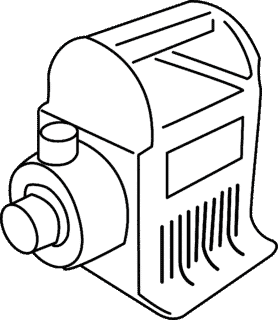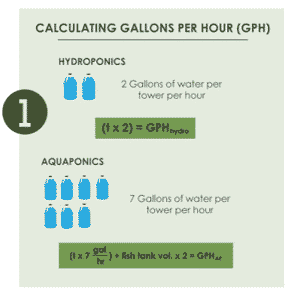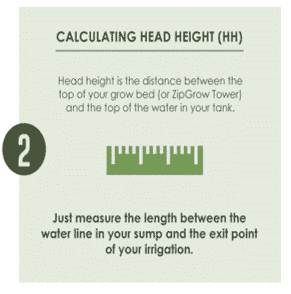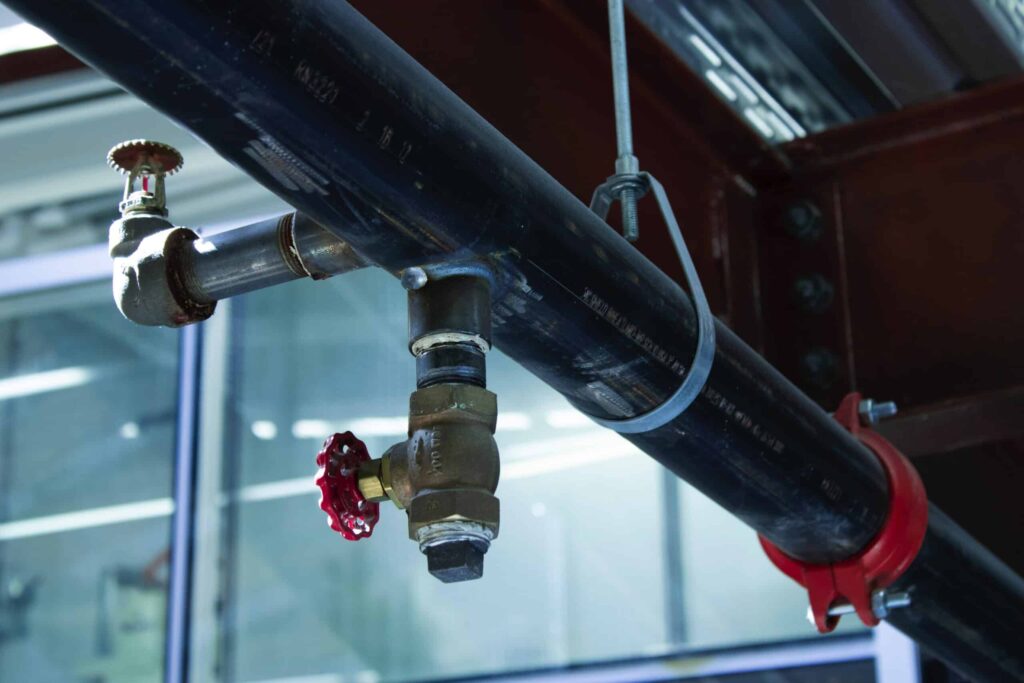So you’re building a system. You’ve got your towers ordered, your greenhouse ready to set up… all that’s left for you to do is to order a pump.
Inline vs Submersible Pumps
Submersible pumps are cooled by the water, size-labeled by GPH, and increase in cost as size goes up. These sit directly in the water of a tank or gutter and pump water through a fitting (and hose that you attach) from the top of the pump.

Inline pumps are air-cooled, sit outside of your tank, and are typically suited best for larger (50 or 100+ tower) operations.
The term “sump pump” refers to a pump that moves water from one sump tank to another or is used for turbulence and mixing nutrients inside one sump tank. We use Active Aqua submersible pumps for this.
An air pump may be used to pump low volumes of air at a high pressure, usually for aerating water. Seedling carts with fertilizer solutions may benefit from an air pump, for example.
Sizing a Pump for your Operation: 3 steps
Figuring out the right size of pump for you isn’t half as complicated as it might seem! We’ve put together easy formulas to use- one for hydroponic growers, and one for aquaponic growers. In order to determine the best pump for your system, you’ll need to do three things:
- Calculate the GPH (gallons per hour) that your pump will be moving
- Measure the head height of your system
- Combine these two value using the handy-dandy chart below!
Step 1
Calculate the required GPH
Calculating GPH for hydroponics
In hydroponics, you want to run two gallons of water through each tower every hour. This means that the number of gallons per hour is essentially the number of towers, times 2, then multiplied again. Of course, you’ll also have a bit of extra water in your sump- a good rule is to add fifty gallons for the sump. So, you end up with a gallons per hour (GPH) for hydroponics equation like this: (where t=towers)
Calculating GPH for aquaponics
In aquaponics, you’ll want to run between seven and ten gallons of water through each tower every hour. Since you’ve got the fish tanks as well, you also need to factor in the fish tank gallons. You’ll also be turning over the fish water twice every hour, so the gallons per hour for aquaponics equation looks (roughly) like this: ( where t=towers)

Step 2
Measure System Head Height
Because almost all aquaponic or hydroponic growers need to move water upwards, you’ll need to also understand how efficient your pump is at different heights. Even if you’re still using a traditional horizontal grow bed model or NFT, as opposed to a high density, productive powerhouse like ZipGrow towers, you’ll still need to move water vertically from your fish tank to your beds or troughs. To compensate for the height, we use a measurement called head height.
Head height is the distance between the top of your grow bed (or ZipGrow tower) and the top of the water in your tank. You won’t even need to do a calculation for this. Just measure the length between the water line in your sump and the exit point of your irrigation (which is probably the drip lines above your towers.) For example, if you have an in-ground sump and a water line at one foot below ground level, and you’re irrigating your towers 5.5 feet above ground, your head height is 6.5 feet. Simple, right?

Step 3
This chart is going to be your cheat sheet for pumps. This one specifically matches the strength of Active Aqua pumps, and other pump brands will come with their own chart. (Make sure you’re using the right chart for your type of pump. Inline pumps and submersible pumps function completely differently.) Using the GPH you calculated and your head height, find the pump that matches your needs. Usually pump efficiency at different head heights is almost never a linear relationship.
Other Important Considerations
System variance: When choosing a pump, remember that our recommendation of turning over your entire system volume at least twice per hour is a recommendation. If you shoot a little long, or fall a little short of this recommendation, everything will probably be just fine. Just remember that every aquaponics or hydroponics system out there varies considerably. Whether it’s the plumbing, system design, grow media, etc., every system is different and required GPH can vary because of it.
The important thing to remember is that if you are growing aquaponically, you must be exchanging your water fast enough to maintain a good level of dissolved oxygen in your system. This is crucial to healthy fish!
Pump efficiency: When researching GPH and various head heights for your own application, remember that you’ll be moving water through what could be quite a long length of hose. That said, the further your system volume travels, the lower your pump’s efficiency will be, and that could mean a decreased GPH or overall system performance.
While it’s possible to do the efficiency calculations here, it’s much more simple just to eyeball it and calculate anywhere from a 15% to 30% loss of efficiency (this of course depends on your plumbing and system design).






